The Influence of Diatomite on the Sound Absorption Ability of Composites
Abstract
:1. Introduction
2. Materials and Methods
3. Experimental
3.1. Morphology Investigations
3.2. Laser Particle Size Analysis
3.3. Thermal Conductivity of Diatomite
3.4. The Acoustic Properties of the Composite
- —sound absorption coefficient,
- —intensity of the sound absorbed,
- —intensity of the incident sound.
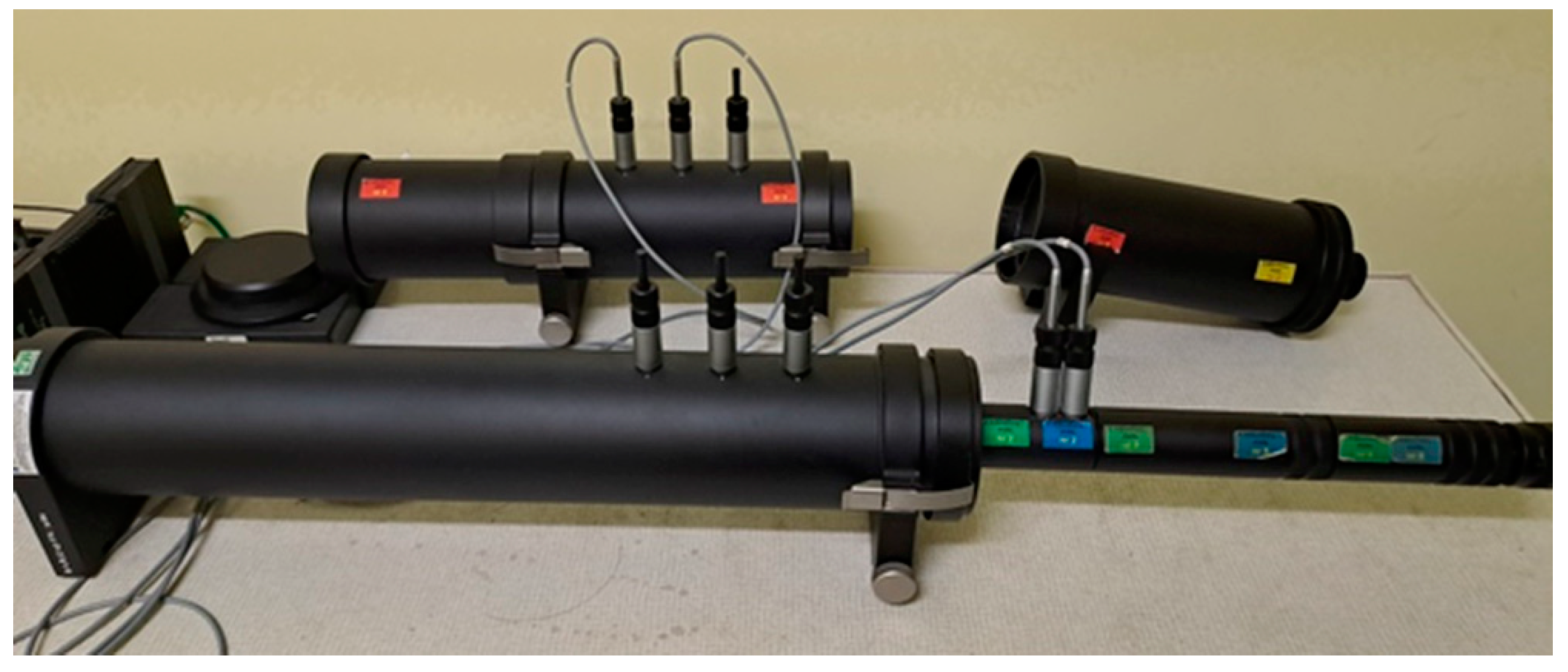
4. Results
4.1. Morphology Investigations
4.2. Laser Particle Size Analysis
4.3. Thermal Conductivity of Diatomite
4.4. The Acoustic Properties of the Composites
4.4.1. Tests in the Frequency Range of 50–1600 Hz
4.4.2. Tests in the Frequency Range of 500–6400 Hz
5. Discussion
6. Conclusions
- Diatomite from Polish deposits is characterized by SiO2 content not exceeding 80 wt.%. In diatomite, there are crystalline phases, such as quartz, illite, kaolinite, and albite;
- The thermal treatment caused an increase in the particle size of the material. This increase was most likely due to permanent binding due to thermal treatment and the presence of a liquid phase;
- The smallest diatomite particles obtained the lowest thermal conductivity coefficient after calcination. The calcination process lowers the thermal conductivity coefficient. When diatomite is used in sound-absorbing composites, thermal insulation is as important as sound absorption capacity (due to the operation of such equipment in different environmental conditions and at different temperatures);
- The smallest fraction of diatomite particles and variants without thermal treatment give the best effect in terms of sound absorption. The calcination process does not positively affect the improvement of acoustic properties.
Author Contributions
Funding
Institutional Review Board Statement
Informed Consent Statement
Data Availability Statement
Acknowledgments
Conflicts of Interest
References
- Bońda, R. Diatomite rock. In Balance of Resources of Fossil Deposits in Poland as of December 31, 2023; Szuflicki, M., Malon, A., Tymiński, M., Eds.; National Geological Institute—National Research Institute: Warsaw, Poland, 2024; pp. 80–81. [Google Scholar]
- Crangle, R.D. Mineral Commodity Summaries 2024. U.S. Geological Survey. 2024. Available online: https://pubs.usgs.gov/periodicals/mcs2024/mcs2024-diatomite.pdf (accessed on 17 July 2024).
- Where Is Diatomite Found. Available online: https://www.mapsofworld.com/minerals/world-diatomite-producers.html (accessed on 17 July 2024).
- Łach, M.; Pławecka, K.; Marczyk, J.; Ziejewska, C.; Hebdowska-Krupa, M.; Nykiel, M.; Hebda, M.; Miernik, K.; Mierzwiński, D.; Korniejenko, K.; et al. Use of diatomite from Polish fields in sustainable development as a sorbent for petroleum substances. J. Clean. Prod. 2023, 389, 136100. [Google Scholar] [CrossRef]
- Lutyński, M.; Sakiewicz, P.; Lutyńska, S. Characterization of Diatomaceous Earth and Halloysite Resources of Poland. Minerals 2019, 9, 670. [Google Scholar] [CrossRef]
- Figarska-Warchoł, B.; Stańczak, G.; Rembiś, M.; Toboła, T. Diatomaceous rocks of the Jawornik deposit (the Polish Outer Carpathians)—Petrophysical and petrographical evaluation. Geol. Geophys. Environ. 2015, 41, 311–331. [Google Scholar] [CrossRef]
- Genclel, O.; del Coz Diaz, J.J.; Sutcu, M.; Koksal, F.; Rabanal, F.P.A.; Martínez-Barrera, G. A novel lightweight gypsum composite with diatomite and polypropylene fibers. Constr. Build. Mater. 2016, 113, 732–740. [Google Scholar] [CrossRef]
- Dai, S.; Zhang, L.; Hao, C.; Qi, P.; Wang, G.; Ma, W. Preparation and characterization of zeolite/diatomite composite materials. Mater. Res. Express 2019, 6, 125516. [Google Scholar] [CrossRef]
- Pavlíková, M.; Záleská, M.; Pivák, A.; Jankovský, O.; Lauermannová, A.-M.; Lojka, M.; Antoncík, F.; Pavlík, Z. MOC-diatomite composites filled with multi-walled carbon nanotubes. Materials 2021, 14, 4576. [Google Scholar] [CrossRef]
- Rubino, C.; Lama, G.C.; Liuzzi, S.; Martellotta, F.; Liguori, B.; Recupido, F.; Verdolotti, L.; Sorrentino, L. Tailoring porosity and acoustic properties in bi-layered diatomite-based foams through multiscale structural approach. Constr. Build. Mater. 2024, 430, 136480. [Google Scholar] [CrossRef]
- Wei, H.; He, Q.; Jiao, Y.; Chen, J.; Hu, M. Evaluation of anti-icing performance for crumb rubber and diatomite compound modified asphalt mixture. Constr. Build. Mater. 2016, 107, 109–116. [Google Scholar] [CrossRef]
- Wu, W.L.; Chen, Z. Modified-diatomite reinforced rubbers. Mater. Lett. 2017, 209, 159–162. [Google Scholar] [CrossRef]
- Wu, W.; Cong, S. Silica and diatomite fillers modified fluorine rubber composites treated by silane-coupling agents. J. Vinyl Addit. Technol. 2020, 26, 55–61. [Google Scholar] [CrossRef]
- Zhang, C.; Wang, J.; Song, S. Preparation of a novel type of flame retardant diatomite and its application in silicone rubber composites. Adv. Powder Technol. 2019, 30, 1567–1575. [Google Scholar] [CrossRef]
- Qian, T.; Li, J.; Deng, Y. Pore structure modified diatomite supported PEG composites for thermal energy storage. Sci. Rep. 2016, 6, 32392. [Google Scholar] [CrossRef]
- Karaman, S.; Karaipekli, A.; Sari, A.; Bicer, A. Polyethylene glycol (PEG)/diatomite composite as a novel form-stable phase change material for thermal energy storage. Sol. Energy Mater. Sol. Cells 2011, 95, 1647–1653. [Google Scholar] [CrossRef]
- Xu, T.; Wu, F.; Zou, T.; Li, J.; Yang, J.; Zhou, X.; Liu, D.; Bie, Y. Development of diatomite-based shape-stabilized composite phase change material for use in floor radiant heating. J. Mol. Liq. 2022, 348, 118372. [Google Scholar] [CrossRef]
- Song, J.; Cao, X.; Huang, Z. Diatomite-chitosan composite with abundant functional groups as efficient adsorbent for vanadium removal: Key influencing factors and influence of surface functional groups. J. Mol. Liq. 2022, 367 Pt A, 120428. [Google Scholar] [CrossRef]
- Fu, Y.; Xu, X.; Huang, Y.; Hu, Y.; Chen, Q.; Wu, Y. Preparation of new diatomite–chitosan composite materials and heir adsorption properties and mechanism of Hg(II). R. Soc. Open Sci. 2017, 4, 170829. [Google Scholar] [CrossRef]
- Dobrosielska, M.; Dobrucka, R.; Brzakalski, D.; Kozera, P.; Martyła, A.; Gabriel, E.; Kurzydłowski, K.J.; Przekop, R. Polyamide 11 composites reinforced with diatomite biofiller—Mechanical, rheological and crystallization properties. Polymers 2023, 15, 1563. [Google Scholar] [CrossRef] [PubMed]
- Kucuk, F.; Sismanoglu, S.; Kanbur, Y.; Tayfun, U. Effect of silane-modification of diatomite on its composites with thermoplastic polyurethane. Mater. Chem. Phys. 2020, 256, 123683. [Google Scholar] [CrossRef]
- Cacciotti, I.; Rinaldi, M.; Fabbrizi, J.; Nanni, F. Innovative polyetherimide and diatomite based composites: Influence of the diatomite kind and treatment. J. Mater. Res. Technol. 2019, 8, 1737–1745. [Google Scholar] [CrossRef]
- Liang, J.Z. Effects of extrusion conditions on die-swell behavior of polypropylene/ diatomite composite melts. Polym. Test. 2008, 27, 936–940. [Google Scholar] [CrossRef]
- Cacciotti, I.; Mori, S.; Cherubini, V.; Nanni, F. Eco-sustainable systems based on poly (lactic acid), diatomite and coffee grounds extract for food packaging. Int. J. Biol. Macromol. 2018, 112, 567–575. [Google Scholar] [CrossRef] [PubMed]
- Lamastra, F.R.; De Angelis, R.; Antonucci, A.; Salvatori, D.; Prosposito, P.; Casalboni, M.; Congestri, R.; Melino, S.; Nanni, F. Polymer composite random lasers based on diatom frustules as scatterers. RSC Adv. 2014, 4, 61809–61816. [Google Scholar] [CrossRef]
- Fazli, Y.; Khezri, K. Mesoporous diatomite-filled PMMA by in situ reverse atom transfer radical polymerization. Colloid Polym. Sci. 2017, 29, 247–257. [Google Scholar] [CrossRef]
- Lv, J.; Sun, B.; Jin, J.; Jiang, W. Mechanical and slow-released property of poly (acrylamide) hydrogel reinforced by diatomite. Mater. Sci. Eng. C 2019, 99, 315–321. [Google Scholar] [CrossRef]
- Li, X.; Li, X.; Wang, G. Surface modification of diatomite using polyaniline. Mater. Chem. Phys. 2007, 102, 140–143. [Google Scholar] [CrossRef]
- Cavodeau, F.; Otazaghine, B.; Sonnier, R.; Lopez-Cuesta, J.M.; Delaite, C. Fire retardancy of ethylene-vinyl acetate composites—Evaluation of synergistic effects between ATH and diatomite fillers. Polym. Degrad. Stab. 2016, 129, 246–259. [Google Scholar] [CrossRef]
- Gültürk, E.A.; Güden, M.; Taşdemirci, A. Calcined and natural frustules filled epoxy matrices: The effect of volume fraction on the tensile and compression behavior. Compos. Part B Eng. 2013, 44, 491–500. [Google Scholar] [CrossRef]
- Taşdemirci, A.; Yüksel, S.; Karsu, D.; Gültürk, E.; Hall, I.W.; Güden, M. Diatom frustule-filled epoxy: Experimental and numerical study of the quasi-static and high strain rate compression behavior. Mater. Sci. Eng. A 2008, 480, 373–382. [Google Scholar] [CrossRef]
- Kabieva, S.; Zhumanazarova, G.; Zhaslan, R.; Zhumabayeva, G.; Ukhov, A.; Fedorishin, D.; Gubankov, A.; Tarikhov, F.; Yerkhan, O.; Kurzina, I.; et al. Obtaining new biocompatible composite materials with antibacterial properties based on diatomite and biologically active compounds. Molecules 2024, 29, 1608. [Google Scholar] [CrossRef]
- Yoon, J.; Kim, H.; Koh, T.; Pyo, S. Microstructural characteristics of sound absorbable porous cement-based materials by incorporating natural fibers and aluminum powder. Constr. Build. Mater. 2020, 243, 118167. [Google Scholar] [CrossRef]
- Lin, J.; Guo, J.; Zhao, Y.; Duan, L.; Jin, S. Microstructure and sound absorption property of diatomite/polyurethane porous composites. Fuhe Cailiao Xuebao/Acta Mater. Compos. Sin. 2014, 31, 1476–1480. [Google Scholar]
- Nguyen, Q.-B.; Vahabi, H.; Rios de Anda, A.; Versace, D.-L.; Langlois, V.; Perrot, C.; Nguyen, V.-H.; Naili, S.; Renard, E. Dual UV-Thermal Curing of Biobased Resorcinol Epoxy Resin-Diatomite Composites with Improved Acoustic Performance and Attractive Flame Retardancy Behavior. Sustain. Chem. 2021, 2, 24–48. [Google Scholar] [CrossRef]
- DIATO Diatomite Sorbent. Available online: https://diato.pl (accessed on 17 July 2024).
- Brudny, K.; Łach, M.; Bąk, A.; Pławecka, K.; Korniejenko, K. Application of diatomite as a substitute for fly ash in foamed geopolymers. J. Phys. Conf. Ser. 2023, 2423, 012028. [Google Scholar] [CrossRef]
- Pławecka, K.; Bąk, A.; Hebdowska-Krupa, M.; Łach, M. The Use of Calcined Diatomite as an Additive to Geopolymeric Materials. Mater. Proc. 2023, 13, 28. [Google Scholar] [CrossRef]
- Marczyk, J.; Pławecka, K.; Hebdowska-Krupa, M.; Nykiel, M.; Łach, M. Research on diatomite from Polish deposits and the possibilities of its use. J. Achiev. Mater. Manuf. Eng. 2022, 115, 5–15. [Google Scholar] [CrossRef]
- Figarska-Warchoł, B.; Rembiś, M.; Stańczak, G. The impact of calcination on changes in the physical and mechanical properties of the diatomites of the Leszczawka Member (the Outer Carpathians, Poland). Geol. Geophys. Environ. 2019, 45, 269. [Google Scholar] [CrossRef]
- Ediz, N.; Bentli, I.; Tatar, I. Improvement in filtration characteristics of diatomite by calcination. Int. J. Miner. Process. 2010, 94, 129–134. [Google Scholar] [CrossRef]
- Hamed, A. A brief and general overview on diatoms and their applications. Egypt. J. Phycol. 2023, 24, 1–53. [Google Scholar] [CrossRef]
- PN-EN 1097-3:2000; Tests of Mechanical and Physical Properties of Aggregates—Determination of Bulk Density and Coarseness. Polish Committee for Standardization: Warsaw, Poland, 2000.
- Far Eastern Group. Available online: https://www.feg.com.tw/en/home/index.aspx (accessed on 17 July 2024).
- Safilin. Available online: https://www.safilin.fr/?lang=pl (accessed on 17 July 2024).
- ASTM C1784; Standard Test Method for Using a Heat Flow Meter Apparatus for Measuring Thermal Storage Properties of Phase Change Materials and Products. International American Society for Testing of Materials: West Conshohocken, PA, USA, 2020.
- ASTM C518; Standard Test Method for Steady-State Thermal Transmission Properties by Means of the Heat Flow Meter Apparatus. International American Society for Testing of Materials: West Conshohocken, PA, USA, 2021.
- ISO 8301; Thermal Insulation—Determination of Steady-State Thermal Resistance and Related Properties—Heat Flow Meter Apparatus. International Standards Organization: London, UK, 1991.
- EN 12664; Thermal Performance of Building Materials and Products. Determination of Thermal Resistance by Means of Guarded Hot Plate and Heat Flow Meter Methods. Dry and Moist Products of Medium and Low Thermal Resistance. European Committee for Standardisation: Brussels, Belgium, 2001.
- PN-EN ISO 10534-2:2024-04; Acoustics—Determination of acoustic properties in impedance tubes—Part 2: Two-Microphone Method for Perpendicular Sound Absorption Coefficient and Perpendicular Sound Insulation. Polish Committee for Standardization: Warsaw, Poland, 2024.
- Nykiel, M.; Korniejenko, K.; Setlak, K.; Melnychuk, M.; Polivoda, N.; Kozub, B.; Hebdowska-Krupa, M.; Łach, M. The Influence of Diatomite Addition on the Properties of Geopolymers Based on Fly Ash and Metakaolin. Materials 2024, 17, 2399. [Google Scholar] [CrossRef]
- Stempkowska, A.; Gawenda, T.; Smoroń, K. The Diatomite Grinding Technology Concept for the Protection of Diatomite Shells and the Control of Product Grading. Materials 2024, 17, 3662. [Google Scholar] [CrossRef]
- Kobylinska, N.; Dudarko, O.; Gładysz-Płaska, A.; Tertykh, V.A.; Majdan, M. Optimal Synthesis of Novel Phosphonic Acid Modified Diatomite Adsorbents for Effective Removal of Uranium(VI) Ions from Aqueous Solutions. Materials 2023, 16, 5263. [Google Scholar] [CrossRef] [PubMed]
- Hoang, A.T.; Nižetić, S.; Duong, X.Q.; Rowinski, L.; Nguyen, X.P. Advanced super-hydrophobic polymer-based porous absorbents for the treatment of oil-polluted water. Chemosphere 2021, 277, 130274. [Google Scholar] [CrossRef] [PubMed]
- Du, W.; Dai, G.; Wang, B.; Li, Z.; Li, L. Biodegradable porous organosilicone-modified collagen fiber matrix: Synthesis and high oil absorbency. J. Appl. Polym. Sci. 2018, 135, 46264. [Google Scholar] [CrossRef]
- Yadav, S.; Illa, M.P.; Rastogi, T.; Sharma, C.S. High absorbency cellulose acetate electrospun nanofibers for feminine hygiene application. Appl. Mater. Today 2016, 4, 62–70. [Google Scholar] [CrossRef]
- Ivanov, S.E.; Belyakov, A.V. Diatomite and its application. Glass Ceram. 2008, 65, 1–4. [Google Scholar] [CrossRef]
- Skvortsov, A.A.; Luk’yanov, M.N.; Novitsan, Y.V. Sintering and Mechanical Properties of High-Porosity Ceramics Based on Diatomite. Solid State Phenom. 2017, 269, 71–77. [Google Scholar] [CrossRef]
- Skvortsov, A.A.; Nikolaev, V.K.; Luk’yanov, M.N.; Chebeneva, I.E. On the issue of deformation and destruction of porous ceramics based on diatomite. Phys. Solid State 2023, 1, 120. [Google Scholar] [CrossRef]
- Qian, T.; Li, J.; Min, X.; Guan, W.; Deng, Y.; Ning, L. Enhanced thermal conductivity of PEG/diatomite shape-stabilized phase change materials with Ag nanoparticles for thermal energy storage. J. Mater. Chem. A 2015, 3, 8526–8536. [Google Scholar] [CrossRef]
- Qian, T.; Li, J.; Ma, H.; Yang, I. Adjustable thermal property of polyethylene glycol/diatomite shape-stabilized composite phase change material. Polym. Compos. 2016, 37, 854–860. [Google Scholar] [CrossRef]
- Tang, F.; Su, D.; Tang, Y.; Fang, G. Synthesis and thermal properties of fatty acid eutectics and diatomite composites as shape-stabilized phase change materials with enhanced thermal conductivity. Sol. Energy Mater. Sol. Cells 2015, 141, 218–224. [Google Scholar] [CrossRef]
- Gliścińska, E.; Michalak, M.; Krucińska, I.; Kazimierczak, J.; Bloda, A.; Ciechańska, D. Sound Absorbing Composites from Nonwoven and Cellulose Submicrofibres. J. Chem. Chem. Eng. 2013, 7, 942–948. [Google Scholar]
- Krucińska, I.; Gliścińska, E.; Michalak, M.; Ciechańska, D.; Kazimierczak, J.; Bloda, A. Sound-absorbing green composites based on cellulose ultra-short/ultra-fine fibres. Text. Res. J. 2015, 85, 646–657. [Google Scholar] [CrossRef]
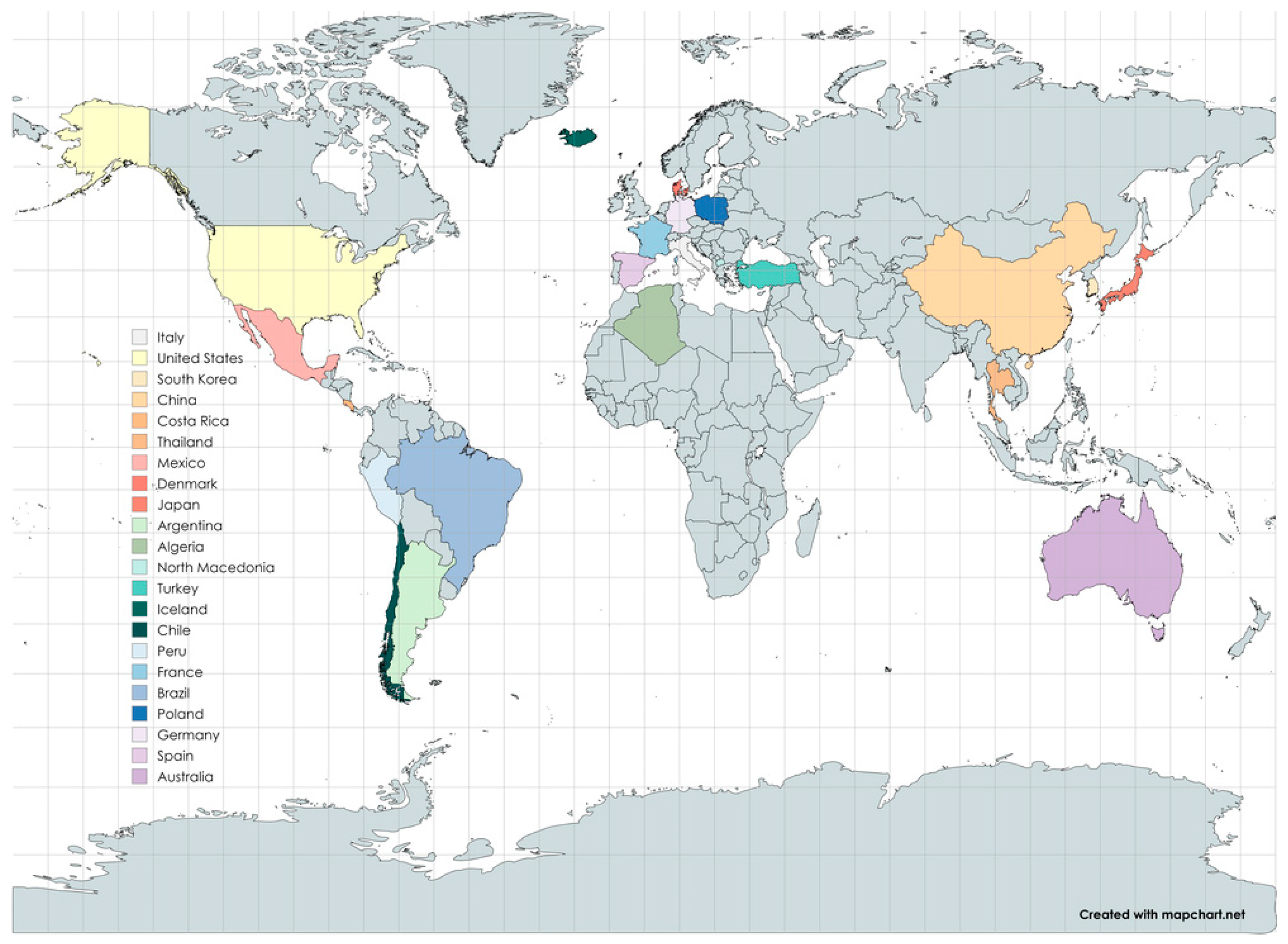
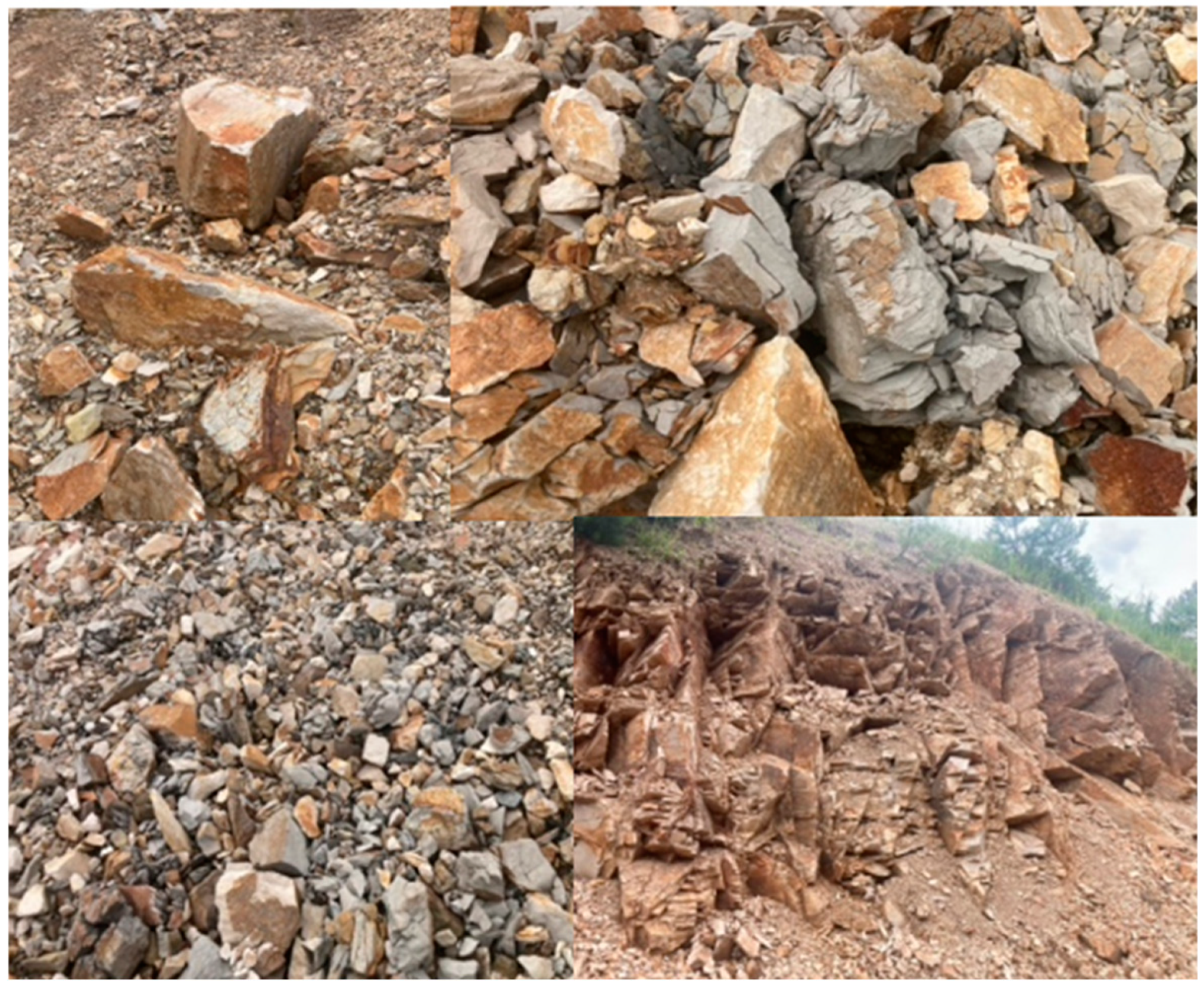
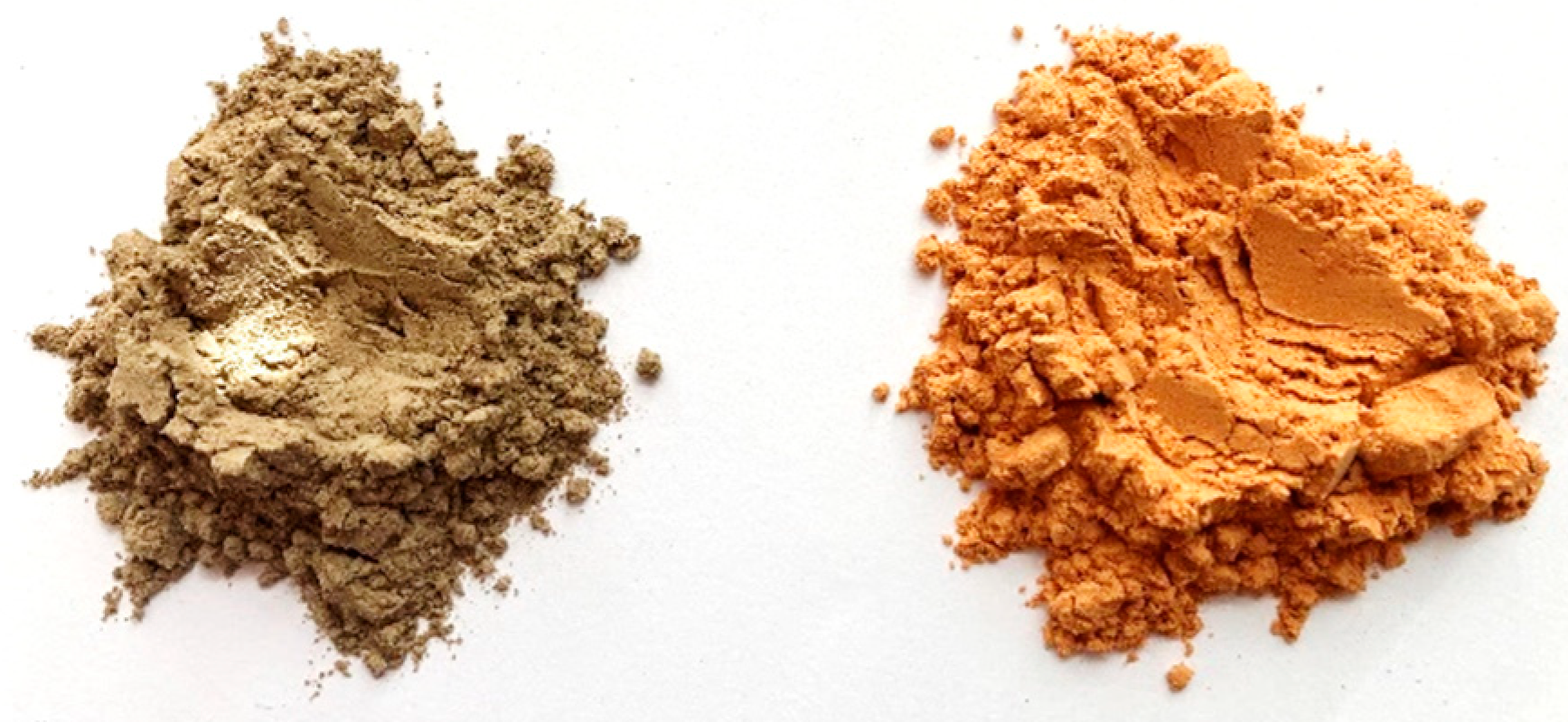



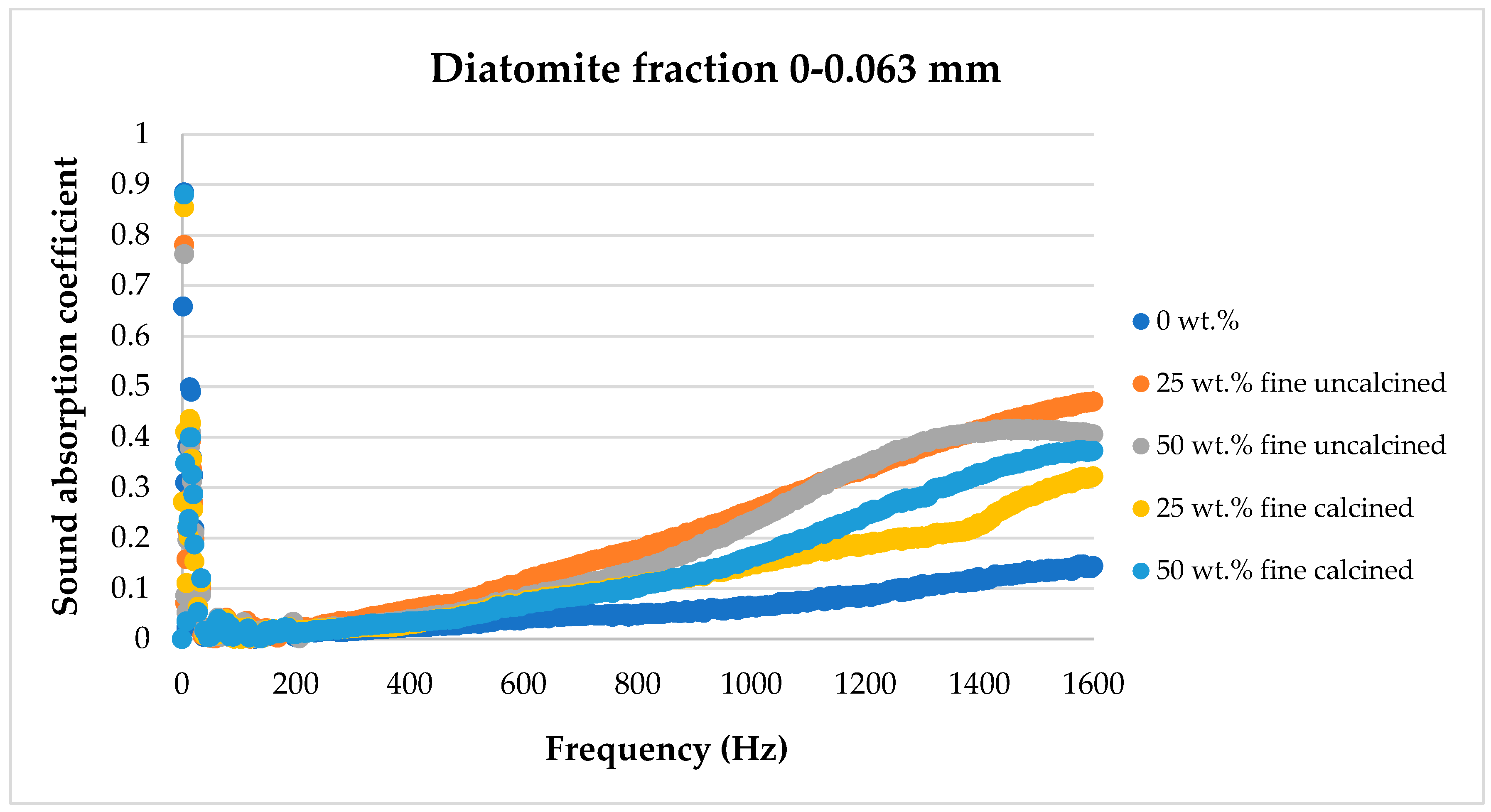
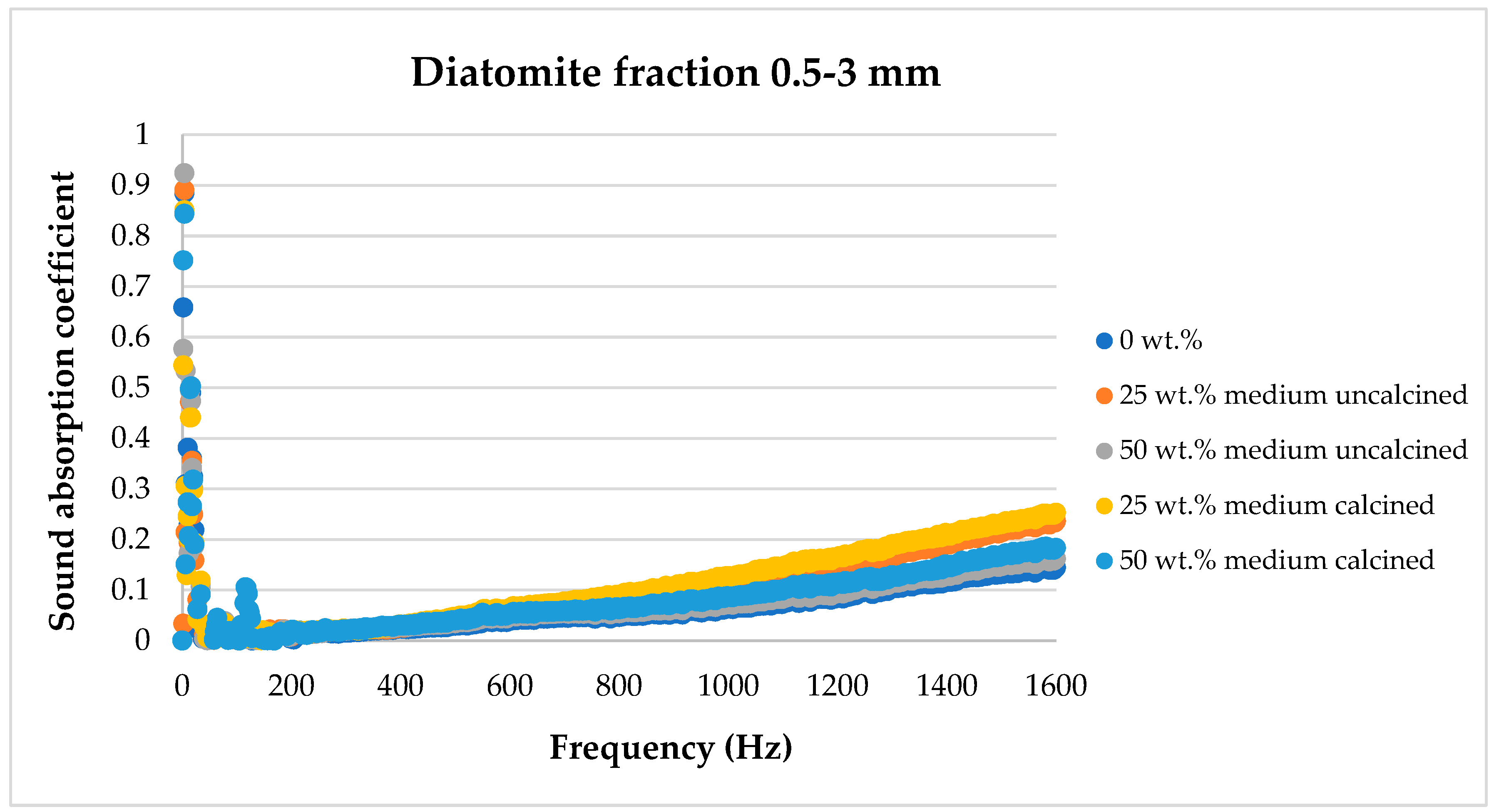
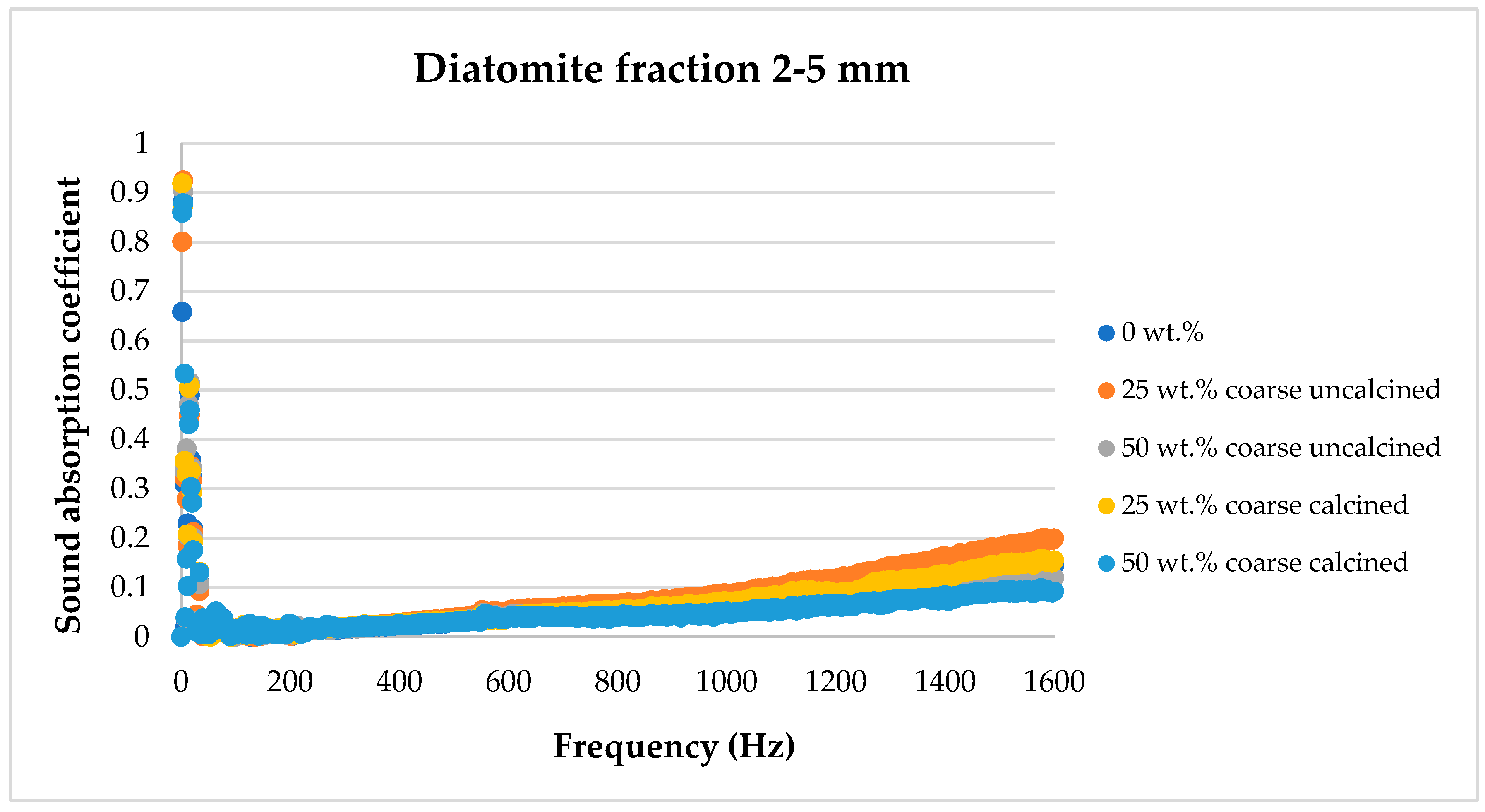
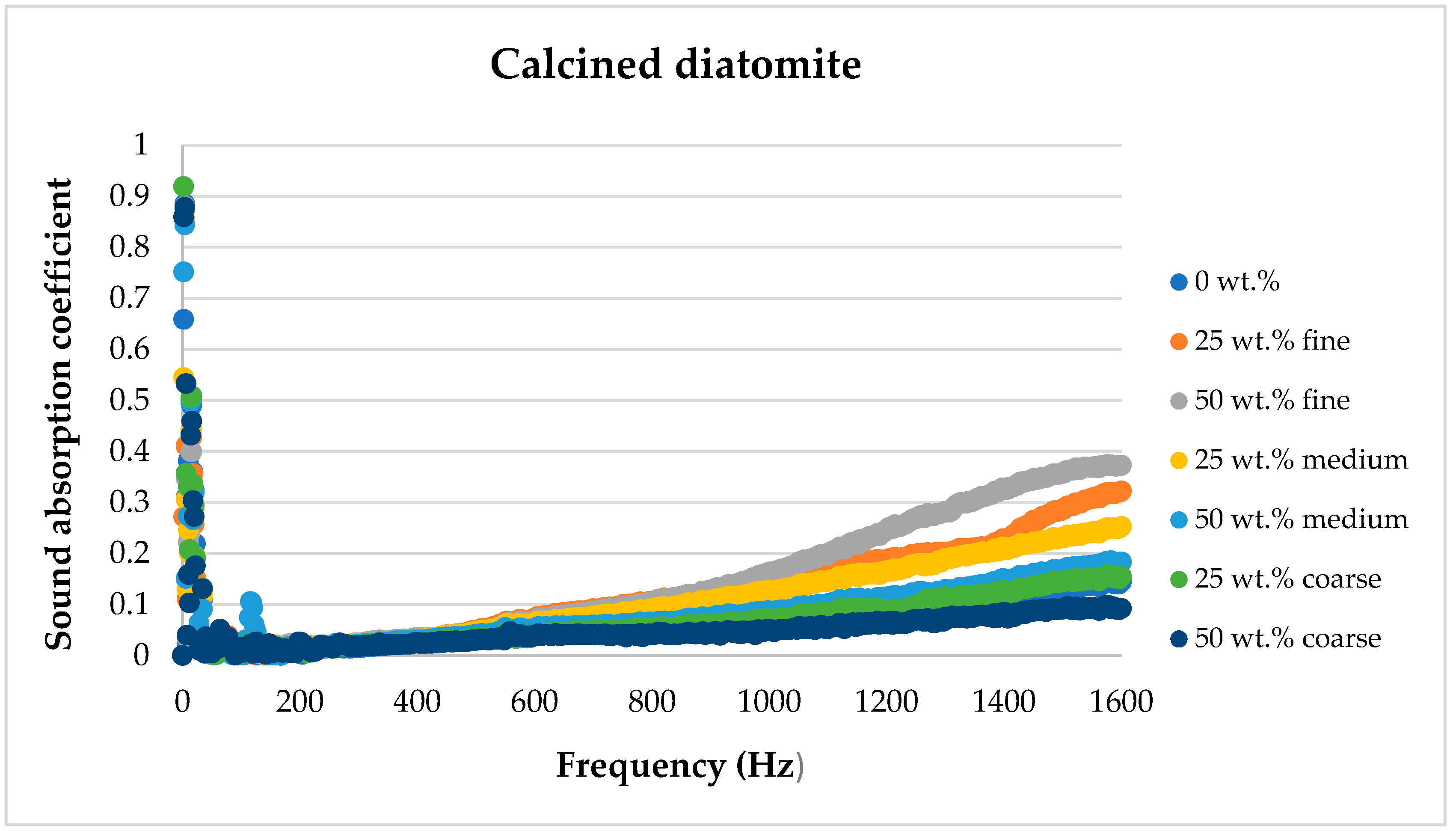
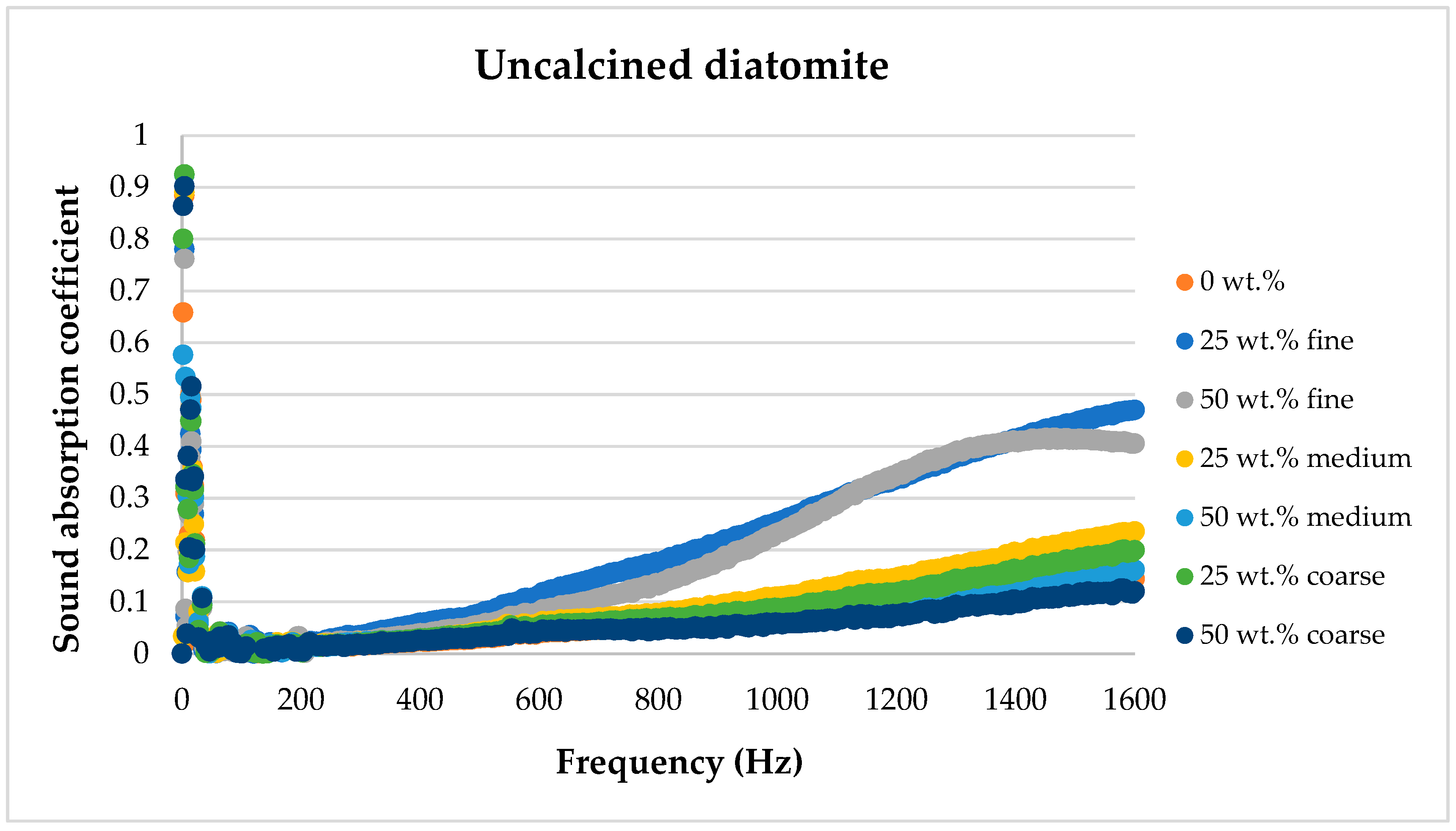
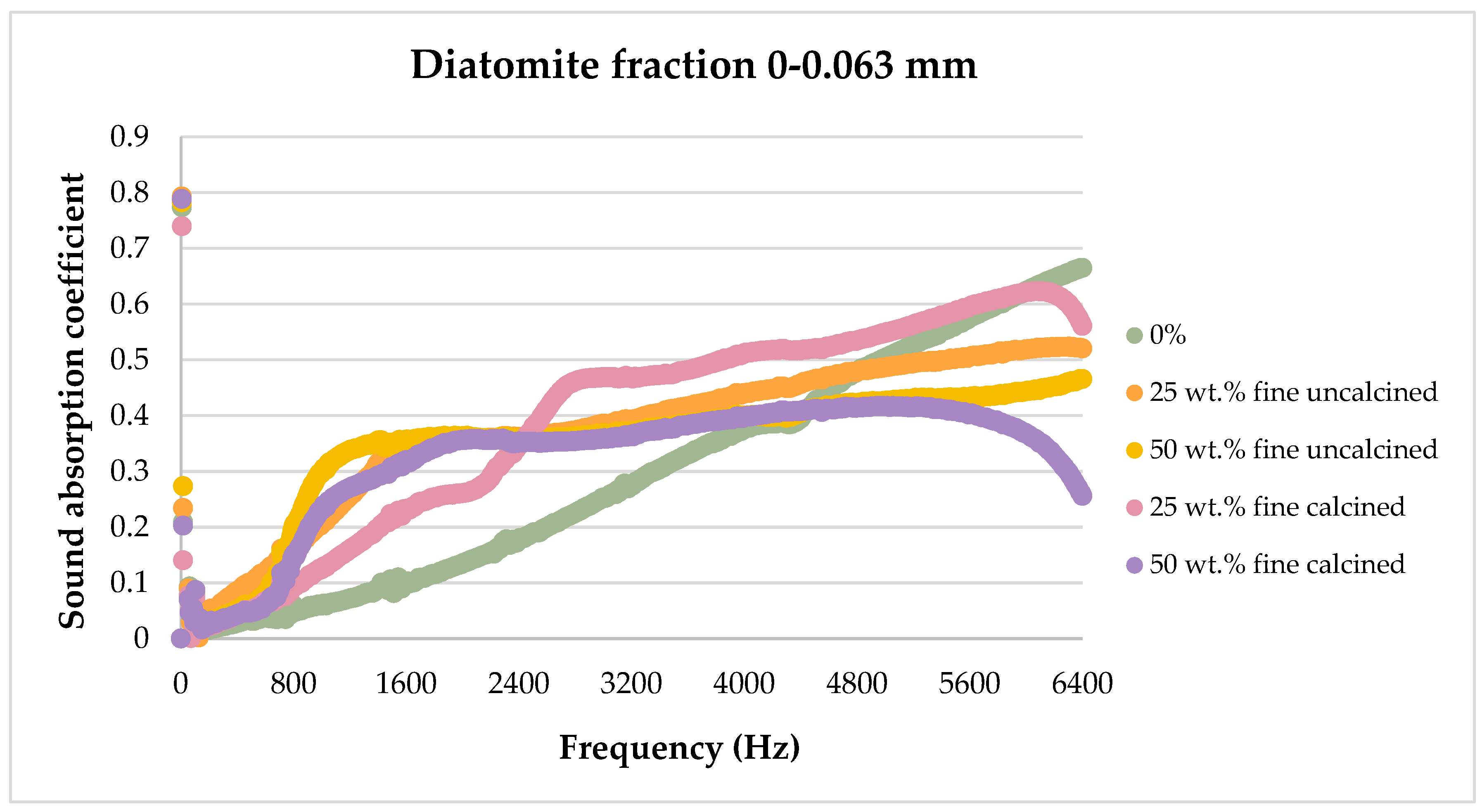
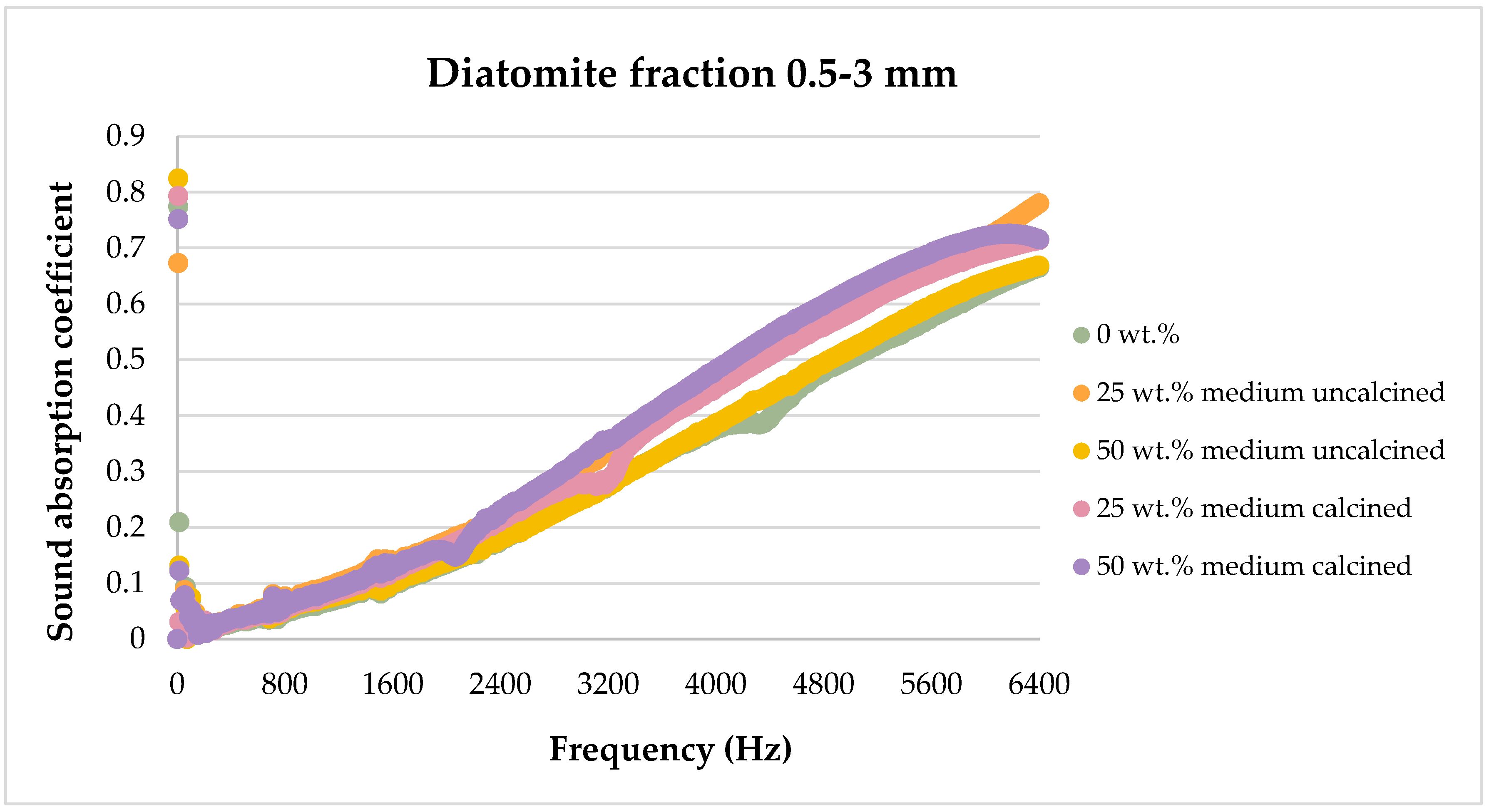
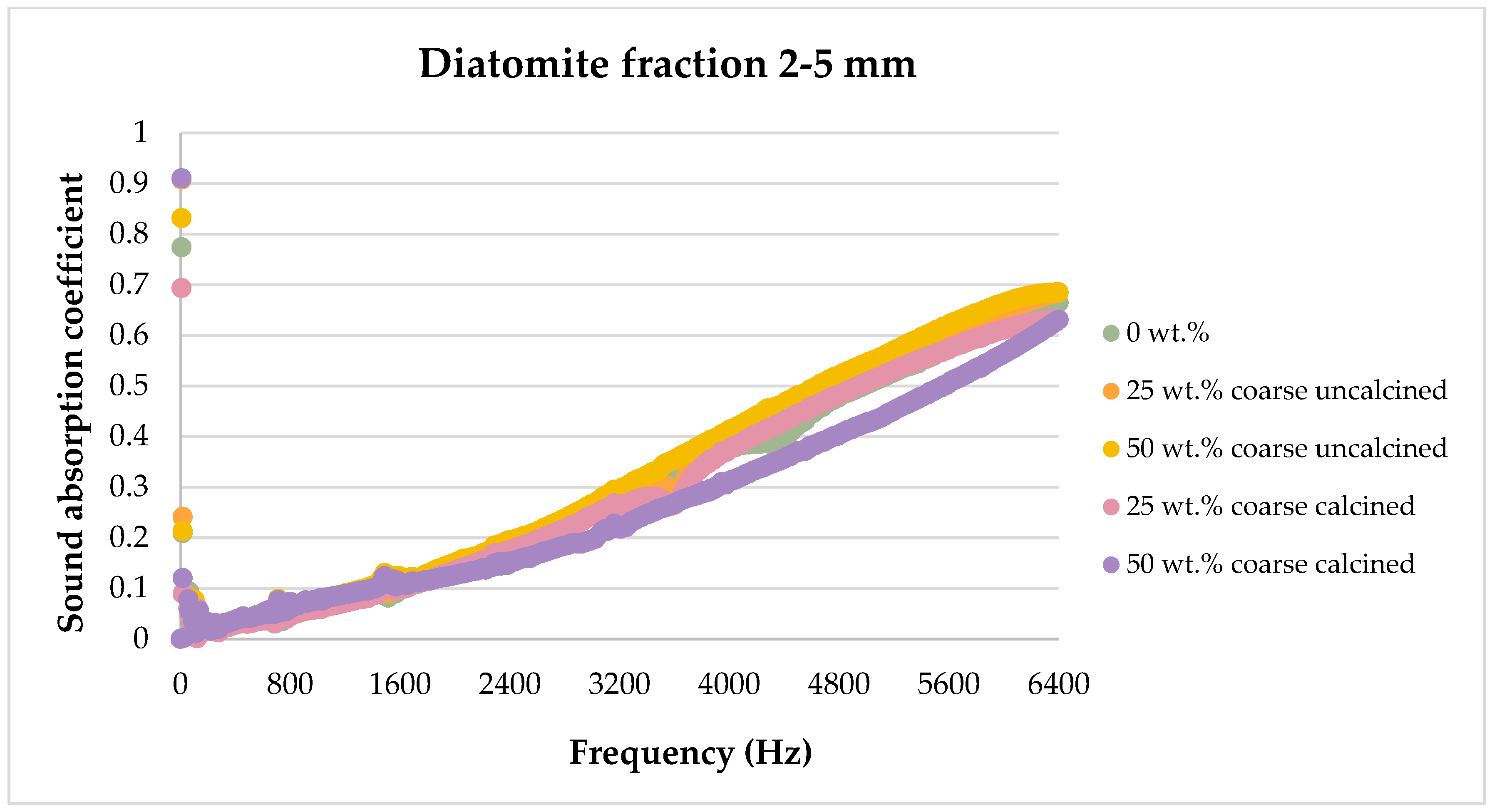
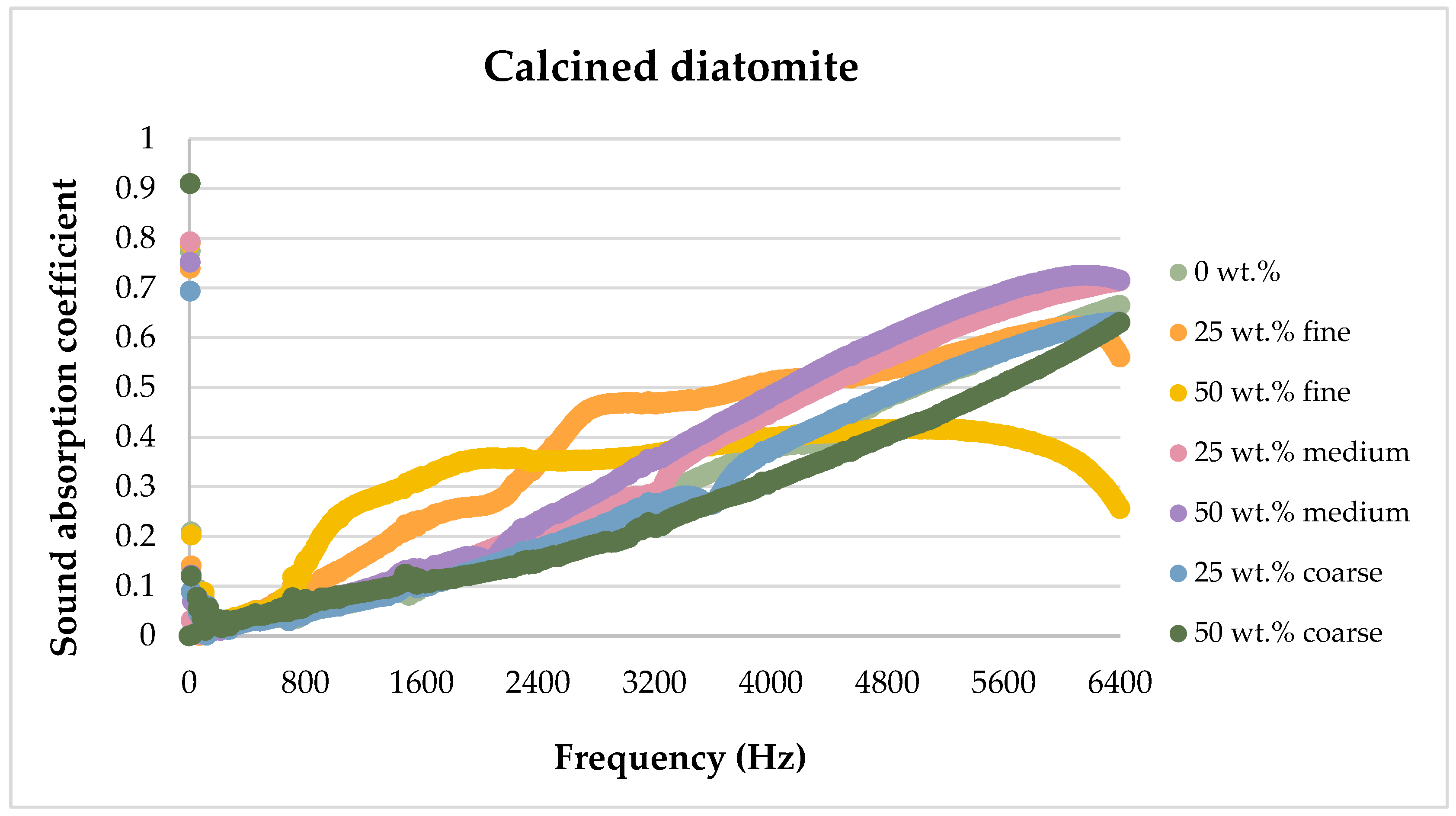
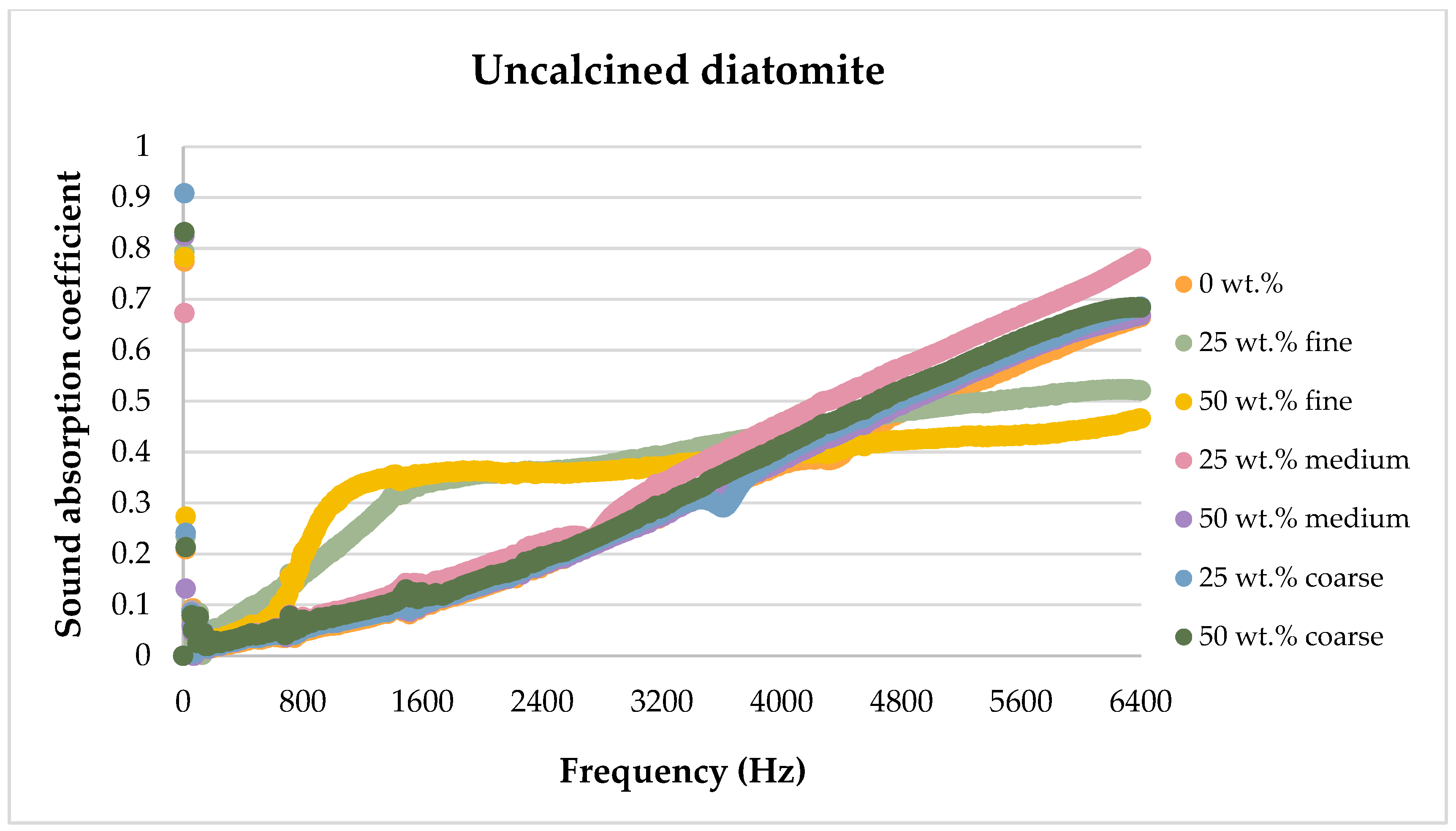
| Type of Diatomite | Oxide Composition (wt.%) | ||||||
|---|---|---|---|---|---|---|---|
| SiO2 | Al2O3 | Fe2O3 | K2O | SO3 | TiO2 | CaO | |
| Raw diatomite | 78.985 | 15.896 | 2.623 | 1.375 | 0.403 | 0.350 | 0.280 |
| Calcinated diatomite | 79.594 | 15.415 | 2.463 | 1.402 | 0.402 | 0.351 | 0.280 |
| Type of Diatomite | Quantitative Share of Phase [%] | |||
|---|---|---|---|---|
| Quartz | Illite | Kaolinite | Albite | |
| 01-075-8321 | 00-026-0911 | 00-058-2001 | 00-001-0739 | |
| SiO2 | Al2Si3AlO10(OH)2 | Al2Si2O5(OH)4 | NaAlSi3O8 | |
| Raw diatomite | 21.4 | 22.1 | 40.4 | 16.1 |
| Calcined diatomite | 26.4 | 16.3 | 39.9 | 17.3 |
| Material | D10 [μm] | D50 [μm] | D90 [μm] | Average Particle Size [μm] | Standard Deviation [μm] |
|---|---|---|---|---|---|
| Raw diatomite | 2.536 | 10.633 | 25.991 | 13.315 | 0.398 |
| Calcinated diatomite | 3.948 | 14.488 | 31.578 | 17.240 | 0.075 |
| Type of Diatomite | Thermal Conductivity Coefficient λ [W/m × K] |
|---|---|
| Raw diatomite 0–0.063 mm | 0.07725 |
| Calcinated diatomite 0–0.063 mm | 0.06969 |
| Raw diatomite 0.5–3 mm | 0.15385 |
| Calcinated diatomite 0.5–3 mm | 0.12656 |
| Raw diatomite 2–5 mm | 0.13260 |
| Calcinated diatomite 2–5 mm | 0.11845 |
Disclaimer/Publisher’s Note: The statements, opinions and data contained in all publications are solely those of the individual author(s) and contributor(s) and not of MDPI and/or the editor(s). MDPI and/or the editor(s) disclaim responsibility for any injury to people or property resulting from any ideas, methods, instructions or products referred to in the content. |
© 2024 by the authors. Licensee MDPI, Basel, Switzerland. This article is an open access article distributed under the terms and conditions of the Creative Commons Attribution (CC BY) license (https://creativecommons.org/licenses/by/4.0/).
Share and Cite
Łach, M.; Gliścińska, E.; Przybek, A.; Smoroń, K. The Influence of Diatomite on the Sound Absorption Ability of Composites. Materials 2024, 17, 4590. https://doi.org/10.3390/ma17184590
Łach M, Gliścińska E, Przybek A, Smoroń K. The Influence of Diatomite on the Sound Absorption Ability of Composites. Materials. 2024; 17(18):4590. https://doi.org/10.3390/ma17184590
Chicago/Turabian StyleŁach, Michał, Eulalia Gliścińska, Agnieszka Przybek, and Krzysztof Smoroń. 2024. "The Influence of Diatomite on the Sound Absorption Ability of Composites" Materials 17, no. 18: 4590. https://doi.org/10.3390/ma17184590








